-
Review: The Terror by Dan Simmons

Dan Simmons attempts to write a supernatural, horror, historical novel version of Moby Dick. Where Melville’s monster was an albino whale stalking Ahab’s Pequod, Simmons conjures up a mythical beast that roams the Arctic Circle slowly picking off the crew of the HMS Terror and Erebus frozen in ice. And like Moby Dick, Terror plods along much too long with unnecessary plot lines and characters that only serve to let the author discuss themes.
Evolution? Check! Nihilism? Check! Absurd 19th century social mores? Check! Evil white man? Check! Noble savage? Check! Alcoholism? Check! Environmental concerns? Eskimo mythology? Betrayal? Love? Cannibalism? Check! And so much more.
What works well within the novel is the depth in which Simmons describes life aboard a Royal Navy ship and what it takes to run it. Using the ill-fated John Franklin expedition, in search for the Northwest Passage as a backdrop, each chapter is told from a crewman’s perspective, with the main character being Captain Francis Crozier. The novel begins mid story and chapters go back and forth into the past (of the expedition, characters lives) to tell how the crew got to its absolutely depressing point.
Pointedly, men die as the novel progresses, in numerous ways. And like the unbearable cold of the Arctic, this tone doesn’t let up. Give us something to hope for, as there’s not much. Like most horror stories, what can go wrong whether it be from sheer character stupidity or the horrific force bearing down upon the characters, will go wrong in Terror. You have to wonder, is anyone intelligent or gives a damn enough to live?
The blend of historical fiction and horror works, however, the unnecessary diversions to draw out themes bloats the story. Melville used an entire chapter on cetalogy, the study of whales. Simmons uses a sermon about Jonah being swallowed by a great fish. There’s a crewman who plays the human villain, who is a homosexual, while there’s a chief crewman who’s also a homosexual who feels like a token character to balance out the other. At one point, Crozier suddenly gains supernatural abilities himself, when there was no inkling that he had them at all. This feels forced.
And then there’s the end, which feels forced, pulled out of nowhere to create a happy ending. Sure, we don’t know what happened to the crew of the Terror and Erebus, more than likely they all froze to death, but their descent into unintelligent-able madness seems a disservice.
-
Thoughts on Fort Worth mayoral campaign signs
On June 18th, the Fort Worth Mayoral run off will be held between Betsy Price and Jim Lane. Through out the entire campaign, their respective signs stood along roadsides and street corners. Regardless of where they fall on the political spectrum, their signage is interesting as well as signage for the other candidates. Below are some thoughts on the designs of all 5 Fort Worth Mayoral candidates, in order of least to most popular vote percentage from the May 14th election. All images found via Google Image’s cache and copyright their respective owners. I have no affiliation with any candidate.
Nicholas Zebrun

All during the campaign, I never once saw this sign. I recall seeing a blue and white sign with some sort of stylized star, nor can I track down any images of the sign I’m thinking of. This design is high contrast sans serif type face, white against red. Zebrun and mayor are weighted, made bold, for impact and visibility. The drop shadow gives the type depth. Aside from the red and white contrast, nothing stands out, nor would I think this to be memorable.
Dan Barrett

Again, we see the high contrast, eye catching red and white design. Barrett has several other things going on. His first name is skewed, albeit disproportionately to his last name. The last name, is skewed in such a way that it gives a sense of perspective–alluding to a path, or a way, or he has perspective on the issues? The skewing, renders the sign, “Dan B”. The tagline, “A New Way for Fort Worth”, is placed in the additional empty space, made by the distortion of his last name. Also, the alignment of the text needs work–Dan and Barrett should be better aligned, as does the tagline. Unless this sign is large, it’s not very readable.
Cathy Hirt
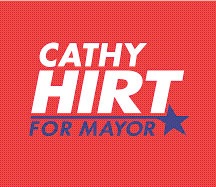
Cathy Hirt’s sign is visually interesting and appealing. Good typography–alignment and weighting of text, plus, the “for mayor” and the star flourish make this attractive. “Hirt” is dramatic and bold–definitely stands out, and the “for mayor” is interesting enough that the brain will make the connection. This sign will work for print and posters. Two concerns, however, are that the blue could be hard to read in passing or if the person was colorblind.
Jim Lane

Jim Lane’s sign is the first to break away from the red and white sans serif design. The other candidates up to this point emphasized their last names. Lane uses the brevity of his seven letters to an advantage–JIM LANE, in a distinctive typeface. The “FOR MAYOR” contrasts well between his name and the longhorn. The longhorn. It’s very similar, if not the same as the City of Fort Worth’s logo, except in a different color. Does it help? Yes. Take it away, and the sign is generic. With the longhorn, it’s an image associated with anything Fort Worth–so much that it could easily blend in with all the other Fort Worth signage as Yet Another Fort Worth Sign.
Betsy Price
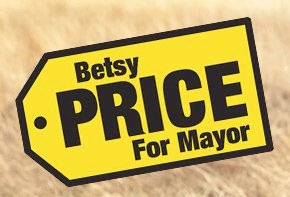
Betsy Price has luck from her namesake to help with a clever, interesting and playful design in that of a “Price” tag. The design is shaped uniquely with high contrast black sans serif text on a yellow background. It’ll work large and small. The similarity to the Best Buy logo is uncanny–and will definitely catch people’s attention. Price’s use of an already existing visual works, whereas Lane’s does not.
Conclusion
High contrast, clean design, visually appealing and, if you can pull it off, add something unique. Plus, use the roadside test. Can you see, and remember, the sign in the brief moments someone may take to look at it? If you can only afford small signs, they better be clear and distinctive.
-
Review: Tina Fey – Bossypants
Tina Fey brings clever wit and charm to her memoir, Bossypants
 that tells of her growth as a creative individual. This creative individual is also a confident woman, business woman, mother, daughter, wife, keen and self aware of the life she lives. All these roles culminate as she recounts the perfect storm of getting Oprah to shoot a scene for 30 Rock, play Sarah Palin for the first time on SNL and pull of her daughter’s third birthday, complete with pirate cake. The lessons she learned from her father, Lorne Michaels, traveling with Second City and running a neighborhood theater kept her together for those crucial few days.
that tells of her growth as a creative individual. This creative individual is also a confident woman, business woman, mother, daughter, wife, keen and self aware of the life she lives. All these roles culminate as she recounts the perfect storm of getting Oprah to shoot a scene for 30 Rock, play Sarah Palin for the first time on SNL and pull of her daughter’s third birthday, complete with pirate cake. The lessons she learned from her father, Lorne Michaels, traveling with Second City and running a neighborhood theater kept her together for those crucial few days.Bossypants brings a female perspective to the creative industry that reads well, and insightful. One interesting passage is her photoshoot for Bust magazine, and she expounds on her feelings towards Photoshop. Fey understands its purpose when used appropriately–enhance images for publication, and recognizes when it crosses the line to distort reality.
It’s knowing those lines, where Fey excels at sharing in a self-deprecating style that makes they key part of an issue relevant.
-
Bloom like an artist
An illustrated parable to growing as an artist by IdaEva.
So true, and applies all the same to any ability to create something.
-
Seryn unplugged in my living room
To get a band to play in your living room, there are several steps to make it happen.
- Find an intimate setting large enough to fit a band and their equipment.
- Get owner of said place to agree to let a band play in their intimate setting.
- Ask said band to play in said intimate setting.
Inspired by two stories posted to Fuel/Friends music blog, by Heather Browne, I pitched the idea to my parents: to put on a show in the living room for my birthday. Reticent to the idea, I strategically, I loaded up the potential band’s music on the kitchen computer and played it for them as I talked about how cool it would be for a 30th birthday experience. Once the soothing, serene harmonies of Seryn filled the kitchen, they began to seem amiable.
“Sure, email the manager, to see if they’ll play.”
A week’s worth of emailing with the band’s manager passed and we worked out a deal. It would cap off a 4 day run of shows for the band. Seryn would play, unplugged, in my living room. I relayed the news to my parents, and they were shocked and impressed, and possibly wondering what they committed themselves to.
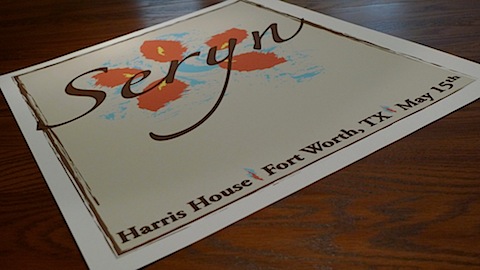
Invites were sent, food ordered, the band’s whisky purchased, last minute details cleared up, logistics finalized, poster made, living room cleared, margarita machines stocked, and the dog tranquilized with doggie downers.

People began arriving around 4:30, and the band followed, unloading around 5. They arrived in their bus, a midnight blue shuttle bus, pulling a trailer for their gear. One by one, they entered the house placing an assortment of instruments from a stand up bass, pump organ, tambourines, banjos and xylophone. And in a small world moment, Nathan, the red-bearded guitarist, and my brother, exchanged glances and immediately recognized each other.
“Hey, I know you… from UNT.”
“Yeah, you were in Bruce…”
“… and you had a girlfriend back home…”
“… you did too…”
“… and we’d talk about it all the time… “
“How you been?!”
Everything was fine.
The stage was set, and fajitas were shared, and margaritas and whisky were dispersed for the set. At five after six, a sizable crowd swelled within the confines of the kitchen to the dining room to the stairs. I thanked everyone for coming, and introduced the band.
Trenton spoke, “Hi, we’re Seryn, and we’re happy to be here to play a few songs for you and celebrate Patrick’s birthday.” And they transitioned into Of Ded Meroz.
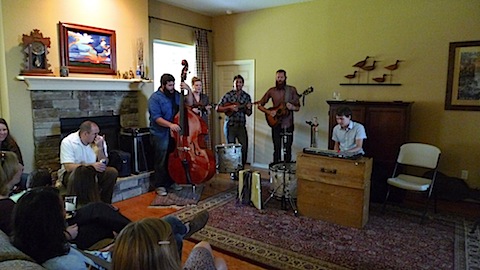
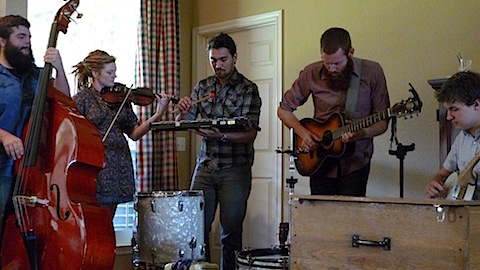
For an hour Seryn played, switching instruments mid song, applying bows to a banjo and a xylophone during On My Knees, singing in 5 part harmony, jamming out, letting the music ebb and swirl and coalesce into a rousing finale of Here We Are. This is a band you have to see live, for their energy, passion and camaraderie, and you can’t help but feel that and get a sense of something bigger, something hopeful, and joyful.
Friends and family lined up at the makeshift merchandise stand at the dining room table, picking up cds for themselves or others and T-shirts, too.
It was a memorable night. Chelsea, Trenton and Nathan told the story of how they all joined up (fyi, an Explosions in the Sky show is involved); my father helping Andrew, the merch guy, fix the band’s box o’ wares; taking a shot of whisky with Trenton and Nathan, Aaron showing me their spiffy Square credit card processor; my friend Mark collecting autographs with a silver Sharpie; my friend Brad suggesting the addition of a cowbell; the margarita machine drained dry; Chris arriving just in time from a wedding.
All in all, I’m incredibly grateful, humbled and appreciative for all the people who came out to celebrate my 30th.
-
Review: Looking for Calvin and Hobbes – Nevin Martell
Nevin Martell writes reverently of Bill Watterson in

Looking for Calvin and Hobbes. The far reaches that Martell goes to find out who Bill Watterson really was, took him into the world of cartooning and going into the depths of Bill Watterson’s past. Numerous cartoonists were interviewed: Jim Davis, Bill Amend, Lynn Johnston, Stephen Pastis and many others. Martell even tracks down childhood friends, teachers, professors and business associates.
He tells of Watterson’s growth as an illustrator doing political cartoons to transitioning full time to a start up strip to Calvin and Hobbes becoming the social behemoth it was on the comic pages. Over the course of this history, Watterson was serious about his craft, cartooning and his characters. So serious that he disputed with his syndicated, threatening to walk about when his contract was renewed. Watterson despised the commercialism and licensing that pervaded comics, and how syndicates controlled the market, with papers keeping old, stale comics alive with artists filling in after a creator had passed on.
But there’s a richness to this story, seeing where characters originated, whether from family or friends to ideals Watterson held dear, which came out in his comics. Martell traces Calvin and Hobbes’ influence to later artists, and while near universal praise is given to Watterson, many still don’t get why he walked away.
Looking for Calvin and Hobbes is an in depth portrait of a man many grew up with, that shunned the spotlight. Well sourced, nuanced and detailed it reads easily, and sometimes it comes across too attached.
While reading, Martell captured what I missed about the strip and what made it unique, and what Watterson brought to the funny pages.
-
What I learned from 46 days of no Facebook
In keeping with the Catholic tradition of sacrificing something for Lent, I chose to give up Facebook. In the past, I’ve given up chocolate, sweets, dessert, beer, alcohol, caffeine, soda, (listening to) music. Forsaking a technological medium that seeks to connect people, and purposefully disconnecting from it, goes against the instant gratification of modern life. I still had email, cell phone, Twitter, a mail box people could send mail to (I received a postcard during that time). At one point, I consulted with a Lentor, to determine if I could view Facebook at all or just my own account. Consensus deemed that viewing Facebook through others to be OK.
As an aside, the term Lentor was coined at a birthday dinner when a friend had a question about not swearing. A different friend quickly intervened, heading off any moral quandary and designating himself as a Lentor, one who can determine the applicable boundaries of a Lenten sacrifice. I’m sure a priest could have served the role, but what lay person wouldn’t want to help set some tangible, real world spiritual chalk lines?
Facebook is pervasive
If Lenten sacrifices have blurry lines, then Facebook obliterates whatever constraints social communication had. For so long, communication remained tethered to the real world. Written letters, phone communication, voice mails, face to face, text messaging seems fairly grounded in comparison. In casual conversation, referencing Facebook is such a common occurrence that Facebook itself is the communication medium. Yes, its content resides on a digital cloud somewhere in California, but consider:
“… posted pictures on Facebook…”
“… on Facebook, [so-and-so] said [funny/stupid/innocuous/inane/sad/maddening comment] on my wall…”
“… received a Facebook invite for…”
“… just send me a message on Facebook…”
“… are you on Facebook?”
“… you can get our hours of operation on Facebook…”
“… did you see [so-and-so’s] status on Facebook?”
[Insert entire recounting of Facebook realm drama here that ultimately makes its way in to every day life.]
While waiting for someone at Blue Mesa, I overheard two different conversations related to things occurring or having occurred on Facebook. It wasn’t the internet, a blog but a website that, as we all learned from watching the Social Network, put the social experience online. A website that stands to make money off electronic social interactions better than any blog ever did.
At a birthday party, I joked with an acquaintance that we weren’t officially friends since we weren’t Facebook friends. Since this occurred during Lent, I told her I couldn’t friend her right away.
“Can it wait until Easter Morning?” I said.
“Sure, I’ll be expecting a friend request at 12:01, Easter Morning.”
“What about after sunrise service?”
The Fear Of Missing Out
Facebook makes us more connected in a passive way, making it easy to see photos, updates and changes in people’s lives. It also accentuates something that’s always existed–the fear of missing out. That sense of anxiety when there’s something out there that we’d like to experience but are not able to for some reason or another, often due to simply not being informed.
In grade school, you’d figure out which birthday party you missed by hearing about it on Monday while hanging out by the monkey bars. Now, someone you don’t even know will upload a photo from a bar while hanging out at a bar with a stuffed monkey in the back room and tag a friend you know, alerting you of fun you never knew existed. Or were invited to.
The fear of missing out applies to keeping up with status updates and the miscellany of conversation commenting on photos, videos or links. We want to be part of those conversations, even if we’re lurking, passively consuming the updates. What if we miss out on something funny, or engaging or interesting? We want to know. This has been true for any media or form of communication. We’re social creatures, despite however much someone claims to be an introvert. We want to be connected to others and validated by others. I’m guessing there’s some evolutionary biology behind connection and validation. Survival of the species, perhaps?
Biologically, within your brain, you’re wired to become engaged with novelty, things that interest you. When something interests you (intellectually, emotionally or physically) your body will crank out various hormones to further engage you. Dopamine, adrenaline, oxycontin are a few, and to enjoy those activities more, we need a more novel or bigger hit of those activities. This is why relationships are hard work–the novelty of the initial attraction wears off, and then you have to work at maintaining that attraction.
And Facebook is an amusement park of attractions, the equivalent of a 100 different roller coasters of digital crack. It’s novel, interesting, engaging, relatively easy to consume and there’s always a reason to come back for more. A good drug dealer gets you hooked with free. All Facebook costs you is time. So a free means to engage passively with social connections leads to all sorts of things, one being the need to keep up with others so you don’t miss out.
Curated lives
In keeping up with others, there’s the opposite, informing others. Anyone who posts things to Facebook is a publisher, a modern day William Randolph Hearst, albeit at a much smaller scale, for a much more individual purpose.
Hearst is credited with saying to a photographer, “You provide the pictures, I’ll provide the war.” Regardless, if he ever said it, the point is that what ever means is used, we can justify the ends to say something. We might not be selectively curating lolcat pictures or YouTube videos for war, but we selectively signal our interests and intentions by what we share or say.
Travels, growing families, melancholy thoughts, persistent witticisms, innocuous oversharing, politics, sports, gossip, social causes, personal happenings… Imagine whatever you publish to Facebook as a room in your own personal gallery. What’s that gallery going to look like? Curators discern what hangs on the wall at a museum with subject matter smarts and an intent to editorialize to show or say something.
Wouldn’t your Facebook postings do the same?
You know yourself (you should), and you want to tell people something, and you choose what you want to say.
You’re curating your own life. And we each have our own reasons for doing that.
Offline
But what about those that don’t reside on Facebook, or never post anything beyond setting up their page with a picture and basic information? I don’t think they’re missing out, despite the pervasiveness and growing necessity to communicate via Facebook. They have their ways of keeping in touch, getting whatever social interaction floats their boat and living life how they want to. Meaningful lives can still be lived without Liking or Statusing or Poking or Inviting or Messaging. Meaningful lives can still be lived with conversations, however infrequent they may occur. Meaningful lives are not defined by the content or quantity of Facebook updates.
-
Cranking
Merlin Mann tells a moving and personal story about creativity, priorities and life.
Sometimes the cranking made something special that will be really useful to people who badly need the comfort and help. But, a staggering amount of the time, my cranking has produced joyless and unemotional bullshit that couldn’t comfort, help, or please anyone. Especially my editor. Who is awesome. There’s no point in doing anything if it doesn’t eventually please my editor. Who is awesome.
-
Review: R.E.M. – Collapse Into Now
R.E.M.’s latest,

Collapse Into Now, seems to span soundscapes, melodies and riffs from their 30+ years. The lead song, Discoverer, the lead riff sounds similar to Finest Worksong. Oh My Heart‘s deep guitar strum is reminiscent of Drive. Every Day Is Yours To Win could fit into New Adventures in Hi-Fi, while That Someone Is You bounces around like Radio Free Europe from 1983.The songs are solid with Michael Stipe’s cryptic lyrics and steadfast delivery. Fast or slow, they remain true to their pop chorus verse chorus structure. Every Day Is Yours To Win feels shimmery with its simple melody and guitar. Closer, Blue, is the most unconventional with no real chorus and feedback laden outro.
Standouts: Uberlin, It Happened Today, Every Day Is Yours To Win
-
This post is full of awesome
The word awesome seems to have become the go to word to describe anything as remotely delightfully cool. In fact, there’s even an Awesome Foundation.
In naming the Awesome Foundation, Hwang said the word captured the organization’s aims perfectly. “Awesome conveys surprise and delight, and that’s at the core of what we’re trying to do. Awesome isn’t necessarily frivolous, but it does convey a sense of fun.†Awesome also co-opts all dissenters. “The good thing is that you can’t really be against the Awesome Foundation, because then you’d be not awesome, and no one wants that,†said Hwang. The foundation’s Toronto chapter had 250 applications for grants in its first month. And two new Awesome Foundation chapters have just started in Beirut and Sri Lanka.
